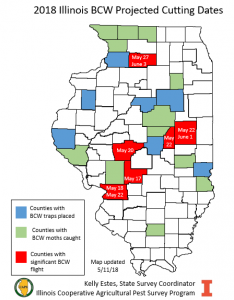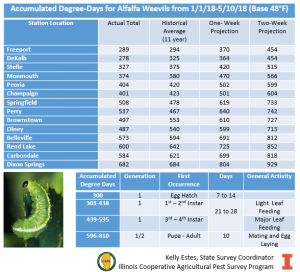Insect Trapping Update:Week Ending May 11, 2018
Black cutworm
Black cutworm moth flights continue across much of Illinois. Several counties reported second -and even third- significant moth flights (Madison, Champaign, and Lee). Several counties had near significant flights (Piatt and Coles). It is important to remember that lack of a reported significant flight and subsequent projected cutting dates does not take black cutworm out of the equation in your area. I have had reported of 1st-2nd instar feeding and even a report of 3rd-4th instar cutting in a couple areas of the state. These reports have been isolated, and under recommended thresholds for rescue treatments.

True Armyworm
While spring storms and southern winds brought black cutworm moths to many areas of Illinois, that is not the case for true armyworm. Trap counts remained low across the state for a second week in a row.
|
Weekly Moth Total (May 5-May 11) |
|
| Northern (Lee County) | 2 |
| West Central (Warren County) | 4 |
| East Central (Champaign County) | 5 |
| Southern (Madison) | 0 |
Corn Rootworm
We remain several weeks from corn rootworm hatch in Illinois. Soil temperatures are warm and degree-day accumulations reflect totals that are slightly ahead of the historical average. We will continue to monitor degree-days and egg hatch.

Alfalfa Weevil
No reports of alfalfa weevil feeding have made their way to the office this week, but varying life stages are possible across the state. A quick refresher on biology, injury and management can be found on the alfalfa weevil factsheet.

Corn Earworm
While we won’t begin trapping for corn earworm for a couple of weeks, Purdue University reports the first 2018 moth catch of the year in Indiana. At this time of year, the catch has little significance on field crops, but is a reminder that spring is truly here and we will be transitioning for our early season insect pests to summer insect pests soon.





